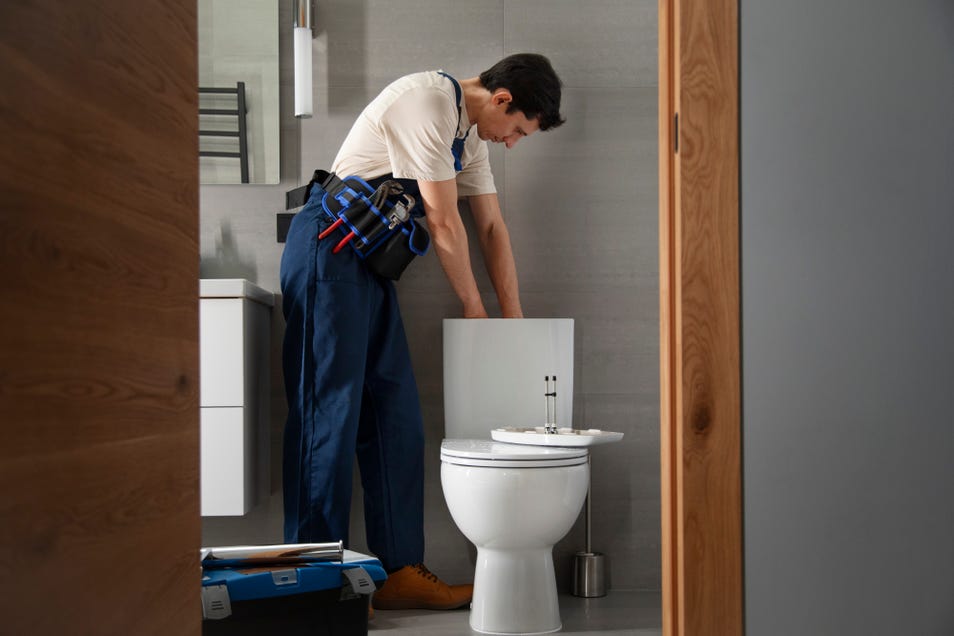How to Drain Toilet Bowl

Removing or replacing your toilet, repairing a leaking base, preventing overflow, or performing any maintenance requires the toilet bowl and tank to be completely drained of water.
Knowing how to drain water from toilet properly is extremely important. Otherwise, the 1.2 to 1.6 gallons of water in the toilet will spill onto the bathroom floor as soon as it’s lifted off the ground
Fortunately, draining a toilet’s tank and bowl is a straightforward task that requires common household supplies.
Keep reading our article about how to drain toilet bowl to find step-by-step instructions and the necessary tools to make the process successful while prioritizing bathroom safety.
How to drain water from toilet
There are various reasons for emptying your toilet bowl. Here’s how to remove water from toilet bowl professionally:
1. Turn off the water valve and flush
The first step in toilet draining is turning off the water valve/supply and flushing. This step removes most of the water from the tank and the bowl. However, if your toilet is clogged, skip this step and move directly to plunging.
Find the water valve (often located where the water supply pipe emerges from the wall or floor) and turn its handle clockwise until it stops. After that, flush the toilet until the tank is empty. The little water left in the bottom of the tank should be no concern as it can be removed by sponging later.
2. Plunge out the water
Plunging is the best method for removing clogs. It forces the water out of the bowl, through the trap, and down the drain.
Place the plunger's flange firmly into the drain hole at the bottom of the toilet bowl. Pump the plunger vigorously with an up-and-down motion to get most of the water out of the bowl.
There’s likely to be a small amount of water left, both in the bottom of the tank and bowl trap, but this remaining water can be removed by sponging.
3. Siphon out the water
Siphoning requires filling up a hose completely with water from a sink or tub and plugging the openings at both ends of the hose with your thumbs so that no water escapes.
After that, dip one end of the hose into the toilet water and the other into a bucket, ensuring the bucket end is lower than the water surface in the bowl.
Release your thumbs from both ends of the hose. The water will begin draining and continue as long as you keep the bowl end submerged and the bucket end lower than the bowl.
If flushing doesn't work, you can use the same method to empty the tank.
4. Sponge out the water
Wear rubber gloves and use a large, absorbent sponge to remove the remaining water from the toilet tank and bowl. Squeeze the sponge over a bucket as you absorb the water, and repeat the process until you are sure the remaining water has disappeared.
5. Vacuum out the water
Use a wet and dry vacuum cleaner to drain the toilet bowl only if the water is clean. Remove the vacuum filter to switch the vacuum to "wet" mode, ensuring the bin is not overfilled, and avoid carrying a heavy bin of toilet water through the house.
FAQs
How do you flush a toilet that won't drain?
To flush a toilet that won’t drain, turn off the water supply valve, use plunging to force as much water out of the bowl as possible, and then try flushing. After that, use a bucket to pour water directly into the bowl, creating enough force to initiate a flush and clear the blockage.
How do you unclog a toilet when water is high?
Follow the instructions below to unclog a toilet bowl when the water level is high:
Boil half a gallon of water, but it shouldn’t be hotter than normal hot tea.
Pour Harpic PowerPlus Original into the clogged toilet bowl by gently placing its nozzle under the rim and squeezing the bottle. It will help you loosen and dissolve the clog.
Pour the hot water into the toilet bowl from near the rim. The force of the water falling into the bowl can help to clear the clog and clean up your toilet.
Is it safe to use a wet-dry vacuum for draining?
A wet-dry vacuum for toilet draining is safe if the water is clean. Just switch the vacuum to “wet” mode and avoid overfilling the bin to prevent spills.
.png?width=70&height=88&format=png&quality=50)